CHEVROLET CAMARO 1967 1.G Chassis Workshop Manual
Manufacturer: CHEVROLET, Model Year: 1967, Model line: CAMARO, Model: CHEVROLET CAMARO 1967 1.GPages: 659, PDF Size: 114.24 MB
Page 191 of 659
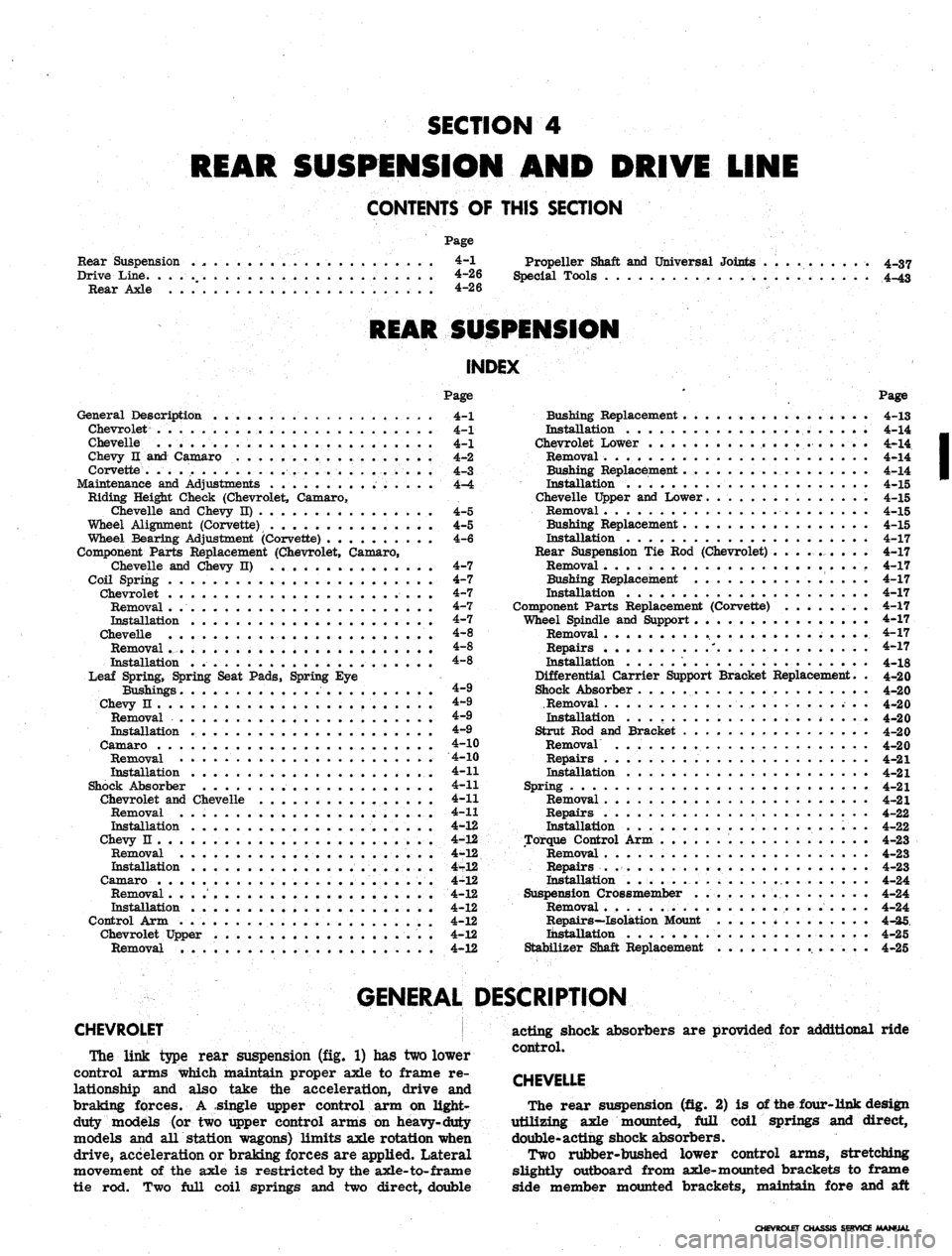
SECTION
4
REAR SUSPENSION
AND
DRIVE LINE
CONTENTS
OF
THIS SECTION
Page
Rear Suspension
4-1
Drive Line.
. 4-26
Rear Axle ......
4-26
Propeller Shaft
and
Universal Joints
Special Tools
4-37
4-43
REAR SUSPENSION
INDEX
General Description
4-1
Chevrolet
4-1
Chevelle
4-1
Chevy
n and
Camaro
. . . . . 4-2
Corvette
. . . . . . 4-3
Maintenance
and
Adjustments ...............
4-4
Riding Height Check (Chevrolet, Camaro,
Chevelle
and
Chevy
II) 4-5
Wheel Alignment (Corvette)
4-5
Wheel Bearing Adjustment (Corvette)
4-6
Component Parts Replacement (Chevrolet, Camaro,
Chevelle
and
Chevy
JJ) 4-7
Coil Spring
4-7
Chevrolet
4-7
Removal
4-7
Installation
4-7
Chevelle
4-8
Removal
4-8
4-8
Installation
.
Leaf Spring, Spring Seat Pads, Spring
Eye
Bushings
4-9
Chevy
H 4-9
Removal
4-9
Installation
4-9
Camaro
4-10
Removal
4-10
Installation
4-11
Shock Absorber
4-11
Chevrolet
and
Chevelle
. 4-11
Removal
4-11
Installation
. . 4-12
Chevy
II 4-12
Removal
4-12
Installation
4-rl2
Camaro
4-12
Removal
. 4-12
Installation
4-12
Control
Arm . . 4-12
Chevrolet Upper
4-12
Removal
. 4-12
Page
Bushing Replacement
. 4-13
Installation
4-14
Chevrolet Lower
4-14
Removal
4-14
Bushing Replacement
4-14
Installation
. 4-15
Chevelle Upper
and
Lower.
. 4-15
Removal
4-15
Bushing Replacement
4-15
Installation
4-17
Rear Suspension
Tie Rod
(Chevrolet)
. . .
......
. . . 4-17
Removal
4-17
Bushing Replacement
4-17
Installation
4-17
Component Parts Replacement (Corvette)
. . 4-17
Wheel Spindle
and
Support
4-17
Removal
4-17
Repairs
', . 4-17
Installation
4-18
Differential Carrier Support Bracket Replacement.
. 4-20
Shock Absorber
4-20
Removal
4-20
Installation
* .... 4-20
Strut
Rod and
Bracket
4-20
Removal
4-20
Repairs
4-21
Installation
4-21
Spring
4-21
Removal
4-21
Repairs
4-22
Installation
4-22
Torque Control
Arm 4-23
Removal
4-23
Repairs
. 4-23
Installation
4-24
Suspension Crossmember
4-24
Removal
4-24
Repairs—Isolation Mount
4-25
Installation
4-25
Stabilizer Shaft Replacement
4-25
GENERAL DESCRIPTION
CHEVROLET
The link type rear suspension (fig. 1) has two lower
control arms which maintain proper axle to frame re-
lationship and also take the acceleration, drive and
braking forces. A single upper control arm on light-
duty models (or two upper control arms on heavy-duty
models and all station wagons) limits axle rotation when
drive, acceleration or braking forces are applied. Lateral
movement of the axle is restricted by the axle-to-frame
tie rod. Two full coil springs and two direct, double
acting shock absorbers are provided for additional ride
control.
CHEVELLE
The rear suspension (fig. 2) is of the four-link design
utilizing axle mounted, full coil springs and direct,
double-acting shock absorbers.
Two rubber-bushed lower control arms, stretching
slightly outboard from axle-mounted brackets to frame
side member mounted brackets, maintain fore and aft
CHEVROLET CHASSIS SERVICE MANUAL
Page 192 of 659
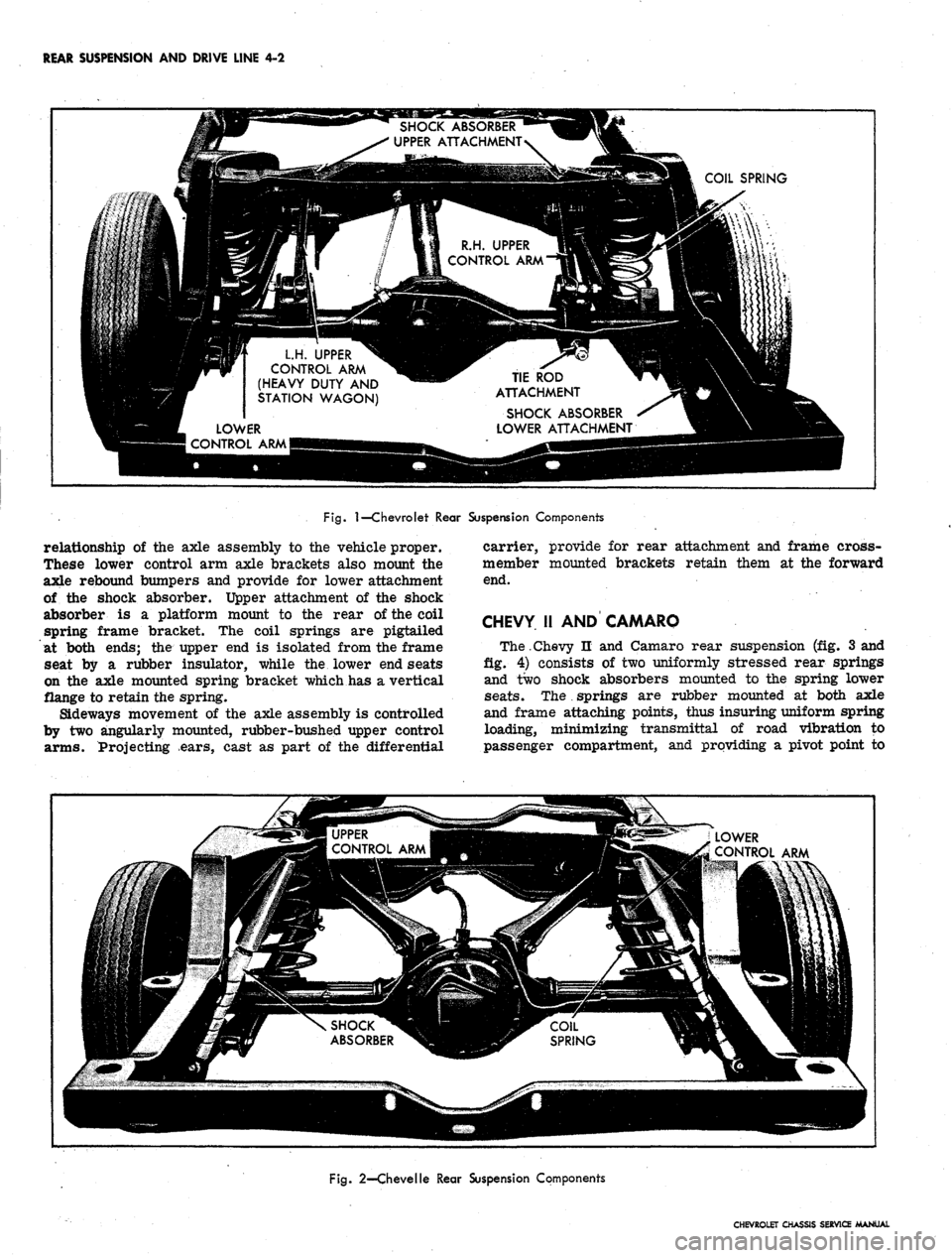
REAR SUSPENSION AND DRIVE LINE 4-2
SHOCK ABSORBER
UPPER ATTACHMENT
COIL SPRING
\
R.H. UPPER
CONTROL ARM
LH.
UPPER
CONTROL ARM
(HEAVY DUTY AND
STATION WAGON)
TIE ROD
ATTACHMENT
SHOCK ABSORBER
LOWER ATTACHMENT
LOWER
CONTROL ARM
Fig.
1—Chevrolet Rear Suspension Components
relationship of the axle assembly to the vehicle proper.
These lower control arm axle brackets also mount the
axle rebound bumpers and provide for lower attachment
of the shock absorber. Upper attachment of the shock
absorber is a platform mount to the rear of the coil
spring frame bracket. The coil springs are pigtailed
at both ends; the upper end is isolated from the frame
seat by a rubber insulator, while the lower end seats
on the axle mounted spring bracket which has a vertical
flange to retain the spring.
Sideways movement of the axle assembly is controlled
by two angularly mounted, rubber-bushed upper control
arms.
Projecting ears, cast as part of the differential
carrier, provide for rear attachment and frame cross-
member mounted brackets retain them at the forward
end.
CHEVY 11 AND CAMARO
The.Chevy n and Camaro rear suspension (fig. 3 and
fig.
4) consists of two uniformly stressed rear springs
and two shock absorbers mounted to the spring lower
seats.
The
.
springs are rubber mounted at both axle
and frame attaching points, thus insuring uniform spring
loading, minimizing transmittal of road vibration to
passenger compartment, and providing a pivot point to
•MMMi
MMM—Hi—1—1——1——1MMMMiM_
[•?{aw-i
'
"'
i
\ SHOCK^^BBB^^B(^^CO1L
ABSORBER ^HH^ SPRING
g^8^"
_ LOWER
feSfcto^
CONTROL
ARM
Fig.
2—Chevelle Rear Suspension Components
CHEVROLET CHASSIS SERVICE MANUAL
Page 193 of 659
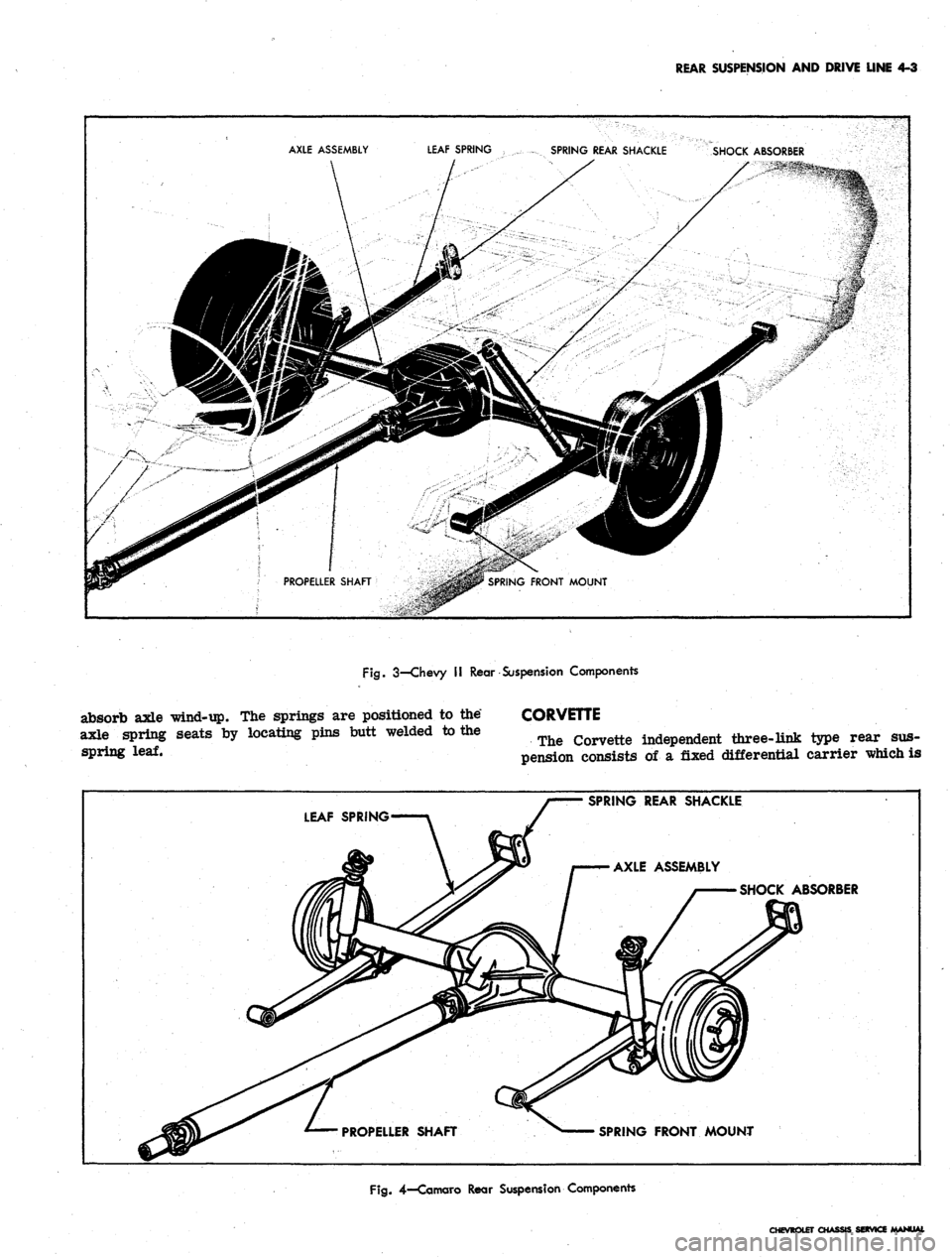
REAR SUSPENSION
AND
DRIVE LINE
4-3
AXLE ASSEMBLY
LEAF SPRING
SPRING REAR SHACKLE
SHOCK ABSORBER
Fig.
3—Chevy
II
Rear Suspension Components
absorb axle "wind-up.
The
springs
are
positioned
to
the*
axle spring seats
by
locating pins butt welded
to
the
spring
leaf.
CORVETTE
The Corvette independent three-link type rear
sus-
pension consists
of a
fixed differential carrier which
is
SPRING REAR SHACKLE
LEAF SPRING
SHOCK ABSORBER
SPRING FRONT MOUNT
Fig.
4—Comoro Rear Suspension Components
CHEVROLET CHASSIS SERVICE MANUAL
Page 194 of 659
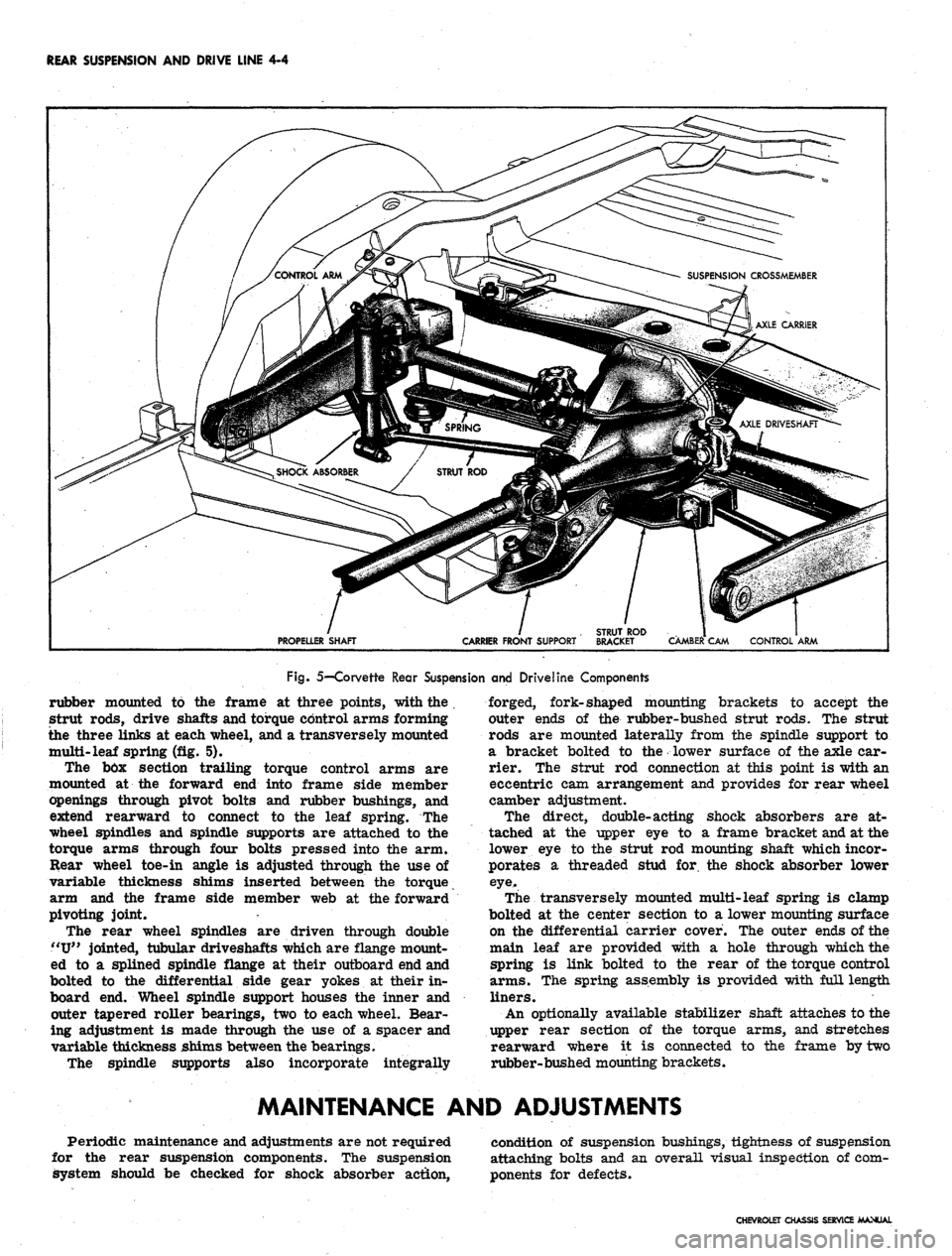
REAR SUSPENSION AND DRIVE LINE
4-4
PROPELLER SHAFT
CARRIER FRONT SUPPORT
CAMBER CAM CONTROL ARM
Fig. 5—Corvette Rear Suspension and Driveline Components
rubber mounted to the frame at three points, with the .
strut rods, drive shafts and torque control arms forming
the three links at each wheel, and a transversely mounted
multi-leaf spring (fig. 5).
The bbx section trailing torque control arms are
mounted at the forward end into frame side member
openings through pivot bolts and rubber bushings, and
extend rearward to connect to the leaf spring. The
wheel spindles and spindle supports are attached to the
torque arms through four bolts pressed into the arm.
Rear wheel toe-in angle is adjusted through the use of
variable thickness shims inserted between the torque
arm and the frame side member web at the forward
pivoting joint.
The rear wheel spindles are driven through double
"U"
jointed, tubular driveshafts which are flange mount-
ed to a splined spindle flange at their outboard end and
bolted to the differential side gear yokes at their in-
board end. Wheel spindle support houses the inner and
outer tapered roller bearings, two to each wheel. Bear-
ing adjustment is made through the use of a spacer and
variable thickness shims between the bearings.
The spindle supports also incorporate integrally
forged, fork-shaped mounting brackets to accept the
outer ends of the rubber-bushed strut rods. The strut
rods are mounted laterally from the spindle support to
a bracket bolted to the lower surface of the axle car-
rier. The strut rod connection at this point is with an
eccentric cam arrangement and provides for rear wheel
camber adjustment.
The direct, double-acting shock absorbers are at-
tached at the upper eye to a frame bracket and at the
lower eye to the strut rod mounting shaft which incor-
porates a threaded stud for. the shock absorber lower
eye.
The transversely mounted multi-leaf spring is clamp
bolted at the center section to a lower mounting surface
on the differential carrier cover. The outer ends of the
main leaf are provided with a hole through which the
spring is link bolted to the rear of the torque control
arms.
The spring assembly is provided with full length
liners.
An optionally available stabilizer shaft attaches to the
upper rear section of the torque arms, and stretches
rearward where it is connected to the frame by two
rubber-bushed mounting brackets.
MAINTENANCE AND ADJUSTMENTS
Periodic maintenance and adjustments are not required
for the rear suspension components. The suspension
system should be checked for shock absorber action,
condition of suspension bushings, tightness of suspension
attaching bolts and an overall visual inspection of com-
ponents for defects.
CHEVROLET CHASSIS SERVICE MANUAL
Page 195 of 659
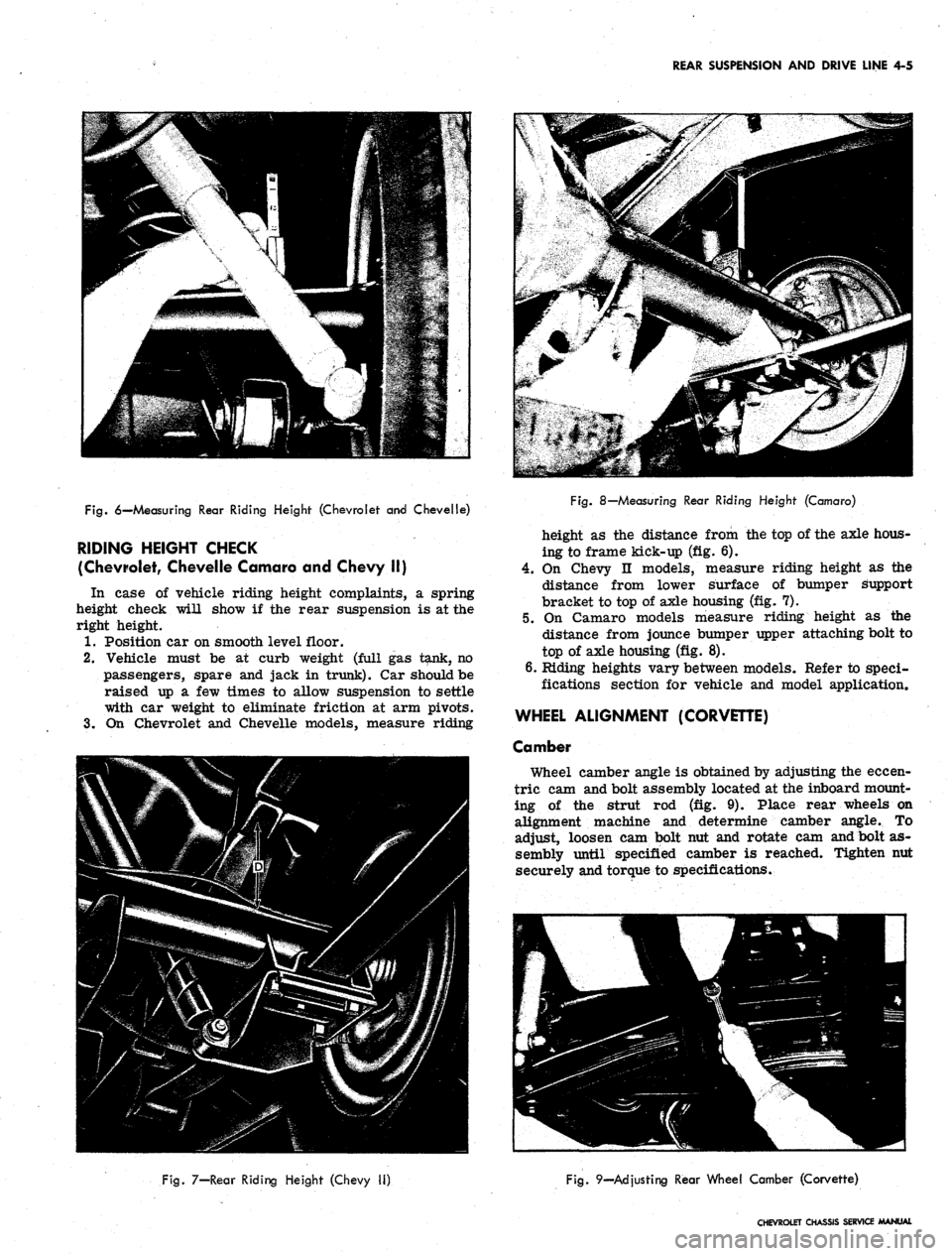
REAR SUSPENSION AND DRIVE LINE 4-5
Fig.
6—Measuring Rear Riding Height (Chevrolet and Chevelle)
RIDING HEIGHT CHECK
(Chevrolet, Chevelle Camaro and Chevy II)
In case of vehicle riding height complaints, a spring
height check will show if the rear suspension is at the
right height.
1.
Position car on smooth level floor.
2.
Vehicle must be at curb weight (full gas tank, no
passengers, spare and jack in trunk). Car should be
raised up a few times to allow suspension to settle
with car weight to eliminate friction at arm pivots.
3.
On Chevrolet and Chevelle models, measure riding
Fig.
8—Measuring Rear Riding Height (Camaro)
height as the distance from the top of the axle hous-
ing to frame kick-up (fig. 6).
4.
On Chevy II models, measure riding height as the
distance from lower surface of bumper support
bracket to top of axle housing (fig. 7).
5.
On Camaro models measure riding height as the
distance from jounce bumper upper attaching bolt to
top of axle housing (fig. 8).
6. Riding heights vary between models* Refer to speci-
fications section for vehicle and model application.
WHEEL ALIGNMENT (CORVETTE)
Camber
Wheel camber angle is obtained by adjusting the eccen-
tric cam and bolt assembly located at the inboard mount-
ing of the strut rod (fig. 9). Place rear wheels on
alignment machine and determine camber angle. To
adjust, loosen cam bolt nut and rotate cam and bolt as-
sembly until specified camber is reached. Tighten nut
securely and torque to specifications.
Fig.
7—Rear Riding Height (Chevy II)
Fig.
9—Ad
justing
Rear Wheel Camber (Corvette)
CHEVROLET CHASSIS SERVICE MANUAL
Page 196 of 659
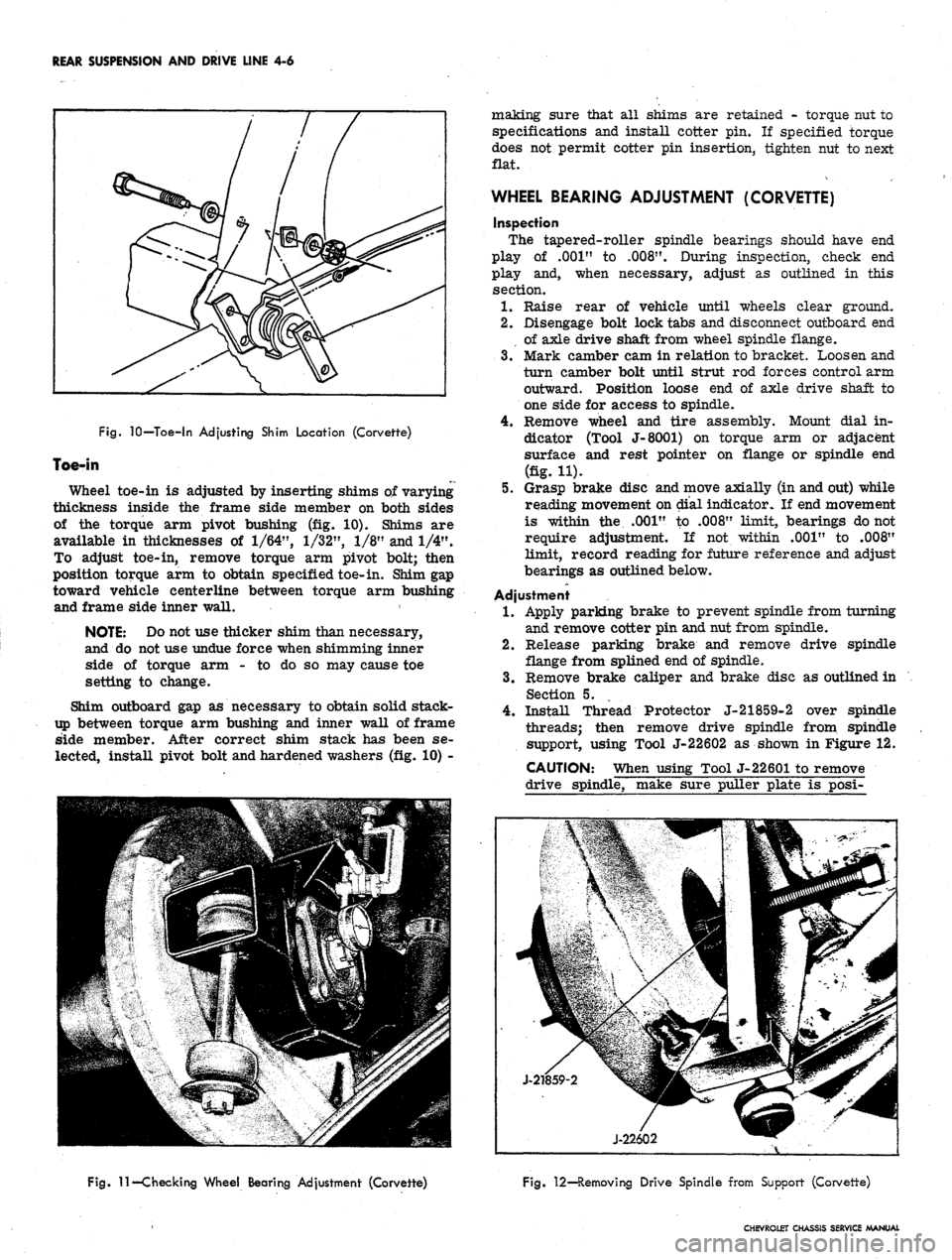
REAR SUSPENSION AND DRIVE LINE 4-6
Fig.
10—Toe-in Adjusting Shim Location (Corvette)
Toe-in
Wheel toe-in is adjusted by inserting shims of varying
thickness inside the frame side member on both sides
of the torque arm pivot bushing (fig. 10). Shims are
available in thicknesses of
1/64",
1/32",
1/8" and 1/4".
To adjust toe-in, remove torque arm pivot bolt; then
position torque arm to obtain specified toe-in. Shim gap
toward vehicle centerline between torque arm bushing
and frame side inner wall.
NOTE: Do not use thicker shim than necessary,
and do not use undue force when shimming inner
side of torque arm - to do so may cause toe
setting to change.
Shim outboard gap as necessary to obtain solid stack-
up between torque arm bushing and inner wall of frame
side member. After correct shim stack has been se-
lected, install pivot bolt and hardened washers (fig. 10) -
making sure that all shims are retained - torque nut to
specifications and install cotter pin. If specified torque
does not permit cotter pin insertion, tighten nut to next
flat.
WHEEL BEARING ADJUSTMENT (CORVETTE)
inspection
The tapered-roller spindle bearings should have end
play of .001" to
.008".
During inspection, check end
play and, when necessary, adjust as outlined in this
section.
1.
Raise rear of vehicle until wheels clear ground.
2.
Disengage bolt lock tabs and disconnect outboard end
of axle drive shaft from wheel spindle flange.
3.
Mark camber cam in relation to bracket. Loosen and
turn camber bolt until strut rod forces control arm
outward. Position loose end of axle drive shaft to
one side for access to spindle.
4.
Remove wheel and tire assembly. Mount dial in-
dicator (Tool J-8001) on torque arm or adjacent
surface and rest pointer on flange or spindle end
(fig. H).
5.
Grasp brake disc and move axially (in and out) while
reading movement on dial indicator. If end movement
is within the .001" to .008" limit, bearings do not
require adjustment. If not within .001" to .008"
limit, record reading for future reference and adjust
bearings as outlined below.
Adjustment
1.
Apply parking brake to prevent spindle from turning
and remove cotter pin and nut from spindle.
2.
Release parking brake and remove drive spindle
flange from splined end of spindle.
3.
Remove brake caliper and brake disc as outlined in
Section 5.
4.
Install Thread Protector J-21859-2 over spindle
threads; then remove drive spindle from spindle
support, using Tool J-22602 as shown in Figure 12.
CAUTION: When using Tool J-22601 to remove
drive spindle, make sure puller plate is posi-
Fig.
11—Checking Wheel Bearing Adjustment (Corvette)
Fig. 12—Removing Drive Spindle from Support (Corvette)
CHEVROLET CHASSIS SERVICE MANUAL
Page 197 of 659
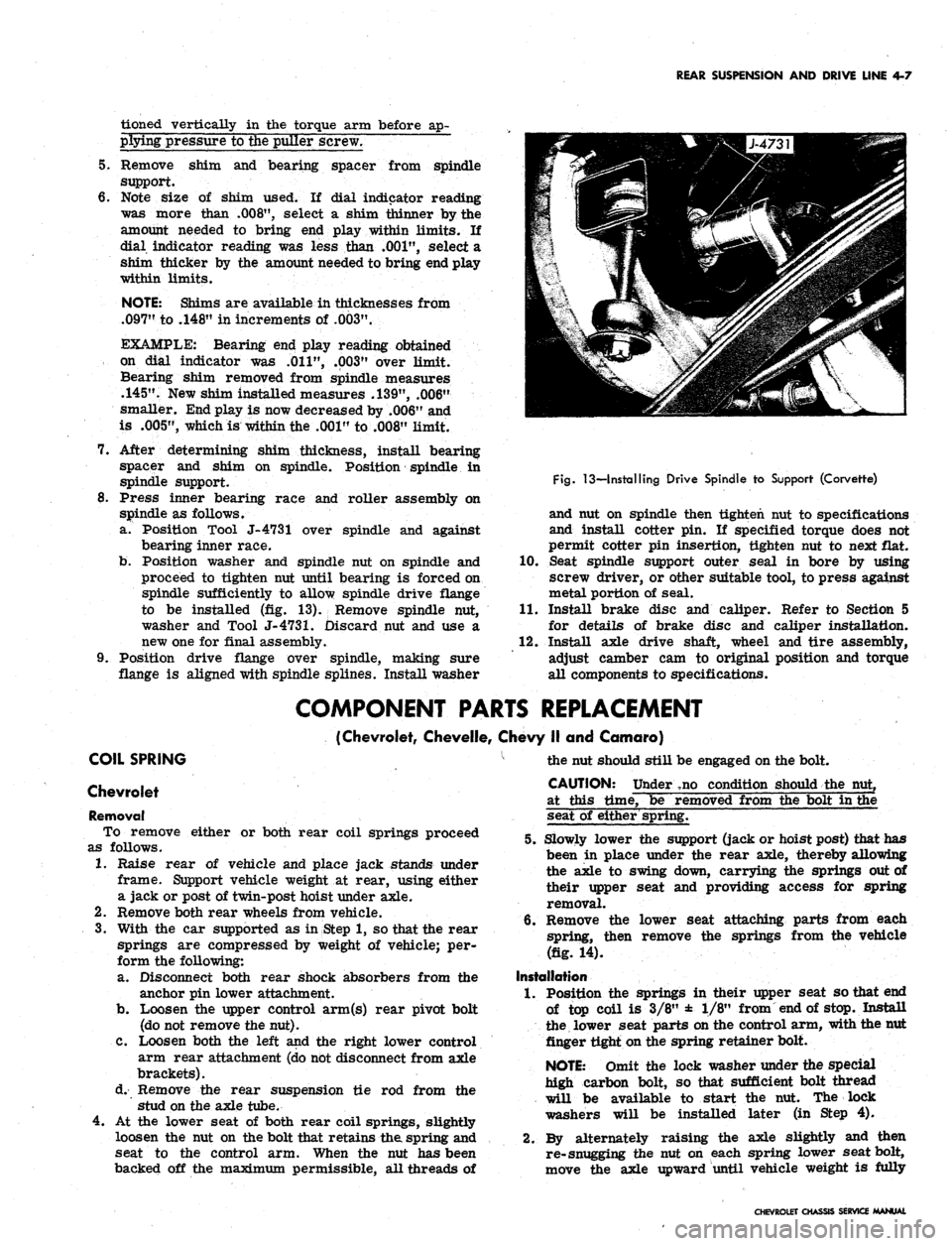
REAR SUSPENSION AND DRIVE LINE 4-7
tioned vertically in the torque arm before ap-
plying pressure to the puller screw.
5.
Remove shim and bearing spacer from spindle
support.
6. Note size of shim used. If dial indicator reading
was more than
.008",
select a shim thinner by the
amount needed to bring end play within limits. If
dial indicator reading was less than
.001",
select a
shim thicker by the amount needed to bring end play
within limits.
NOTE: Shims are available in thicknesses from
.097"
to .148" in increments of
.003".
EXAMPLE: Bearing end play reading obtained
on dial indicator was
.011",
.003" over limit.
Bearing shim removed from spindle measures
.145".
New shim installed measures .139", .006"
smaller. End play is now decreased by .006" and
is
.005",
which is within the .001" to .008" limit.
7.
After determining shim thickness, install bearing
spacer and shim on spindle. Position spindle in
spindle support.
8. Press inner bearing race and roller assembly on
spindle as follows.
a. Position Tool J-4731 over spindle and against
bearing inner race.
b.
Position washer and spindle nut on spindle and
proceed to tighten nut until bearing is forced on
spindle sufficiently to allow spindle drive flange
to be installed (fig. 13). Remove spindle nut,
washer and Tool
J-4731.
Discard nut and use a
new one for final assembly.
9. Position drive flange over spindle, making sure
flange is aligned with spindle splines. Install washer
Fig.
13—Installing Drive Spindle to Support (Corvette)
and nut on spindle then tighten nut to specifications
and install cotter pin. If specified torque does not
permit cotter pin insertion, tighten nut to next flat.
10.
Seat spindle support outer seal in bore by using
screw driver, or other suitable tool, to press against
metal portion of seal.
11.
Install brake disc and caliper. Refer to Section 5
for details of brake disc and caliper installation.
12.
Install axle drive shaft, wheel and tire assembly,
adjust camber cam to original position and torque
all components to specifications.
COMPONENT PARTS REPLACEMENT
(Chevrolet, Chevelle, Chevy II and Camaro)
COIL SPRING
Chevrolet
Removal
To remove either or both rear coil springs proceed
as follows.
1.
Raise rear of vehicle and place jack stands under
frame. Support vehicle weight at rear, using either
a jack or post of twin-post hoist under axle.
2.
Remove both rear wheels from vehicle.
3.
With the car supported as in Step 1, so that the rear
springs are compressed by weight of vehicle; per-
form the following:
a. Disconnect both rear shock absorbers from the
anchor pin lower attachment.
b.
Loosen the upper control arm(s) rear pivot bolt
(do not remove the nut).
C. Loosen both the left and the right lower control
arm rear attachment (do not disconnect from axle
brackets).
d. Remove the rear suspension tie rod from the
stud on the axle tube.
4.
At the lower seat of both rear coil springs, slightly
loosen the nut on the bolt that retains the spring and
seat to the control arm. When the nut has been
backed off the maximum permissible, all threads of
the nut should still be engaged on the bolt.
CAUTION: Under ,no condition should the nut,
at this time, be removed from the bolt in the
seat of either spring.
5.
Slowly lower the support (jack or hoist post) that has
been in place under the rear axle, thereby allowing
the axle to swing down, carrying the springs out of
their upper seat and providing access for spring
removal.
6. Remove the lower seat attaching parts from each
spring, then remove the springs from the vehicle
(fig. 14).
Installation
1.
Position the springs in their upper seat so that end
of top coil is 3/8" ± 1/8" from end of stop. Install
the lower seat parts on the control arm, with the nut
finger tight on the spring retainer bolt.
NOTE: Omit the lock washer under the special
high carbon bolt, so that sufficient bolt thread
will be available to start the nut. The lock
washers will be installed later (in Step 4).
2.
By alternately raising the axle slightly and then
re-snugging the nut on each spring lower seat bolt,
move the axle upward until vehicle weight is fully
CHEVROLET CHASSIS SERVICE MANUAL
Page 198 of 659
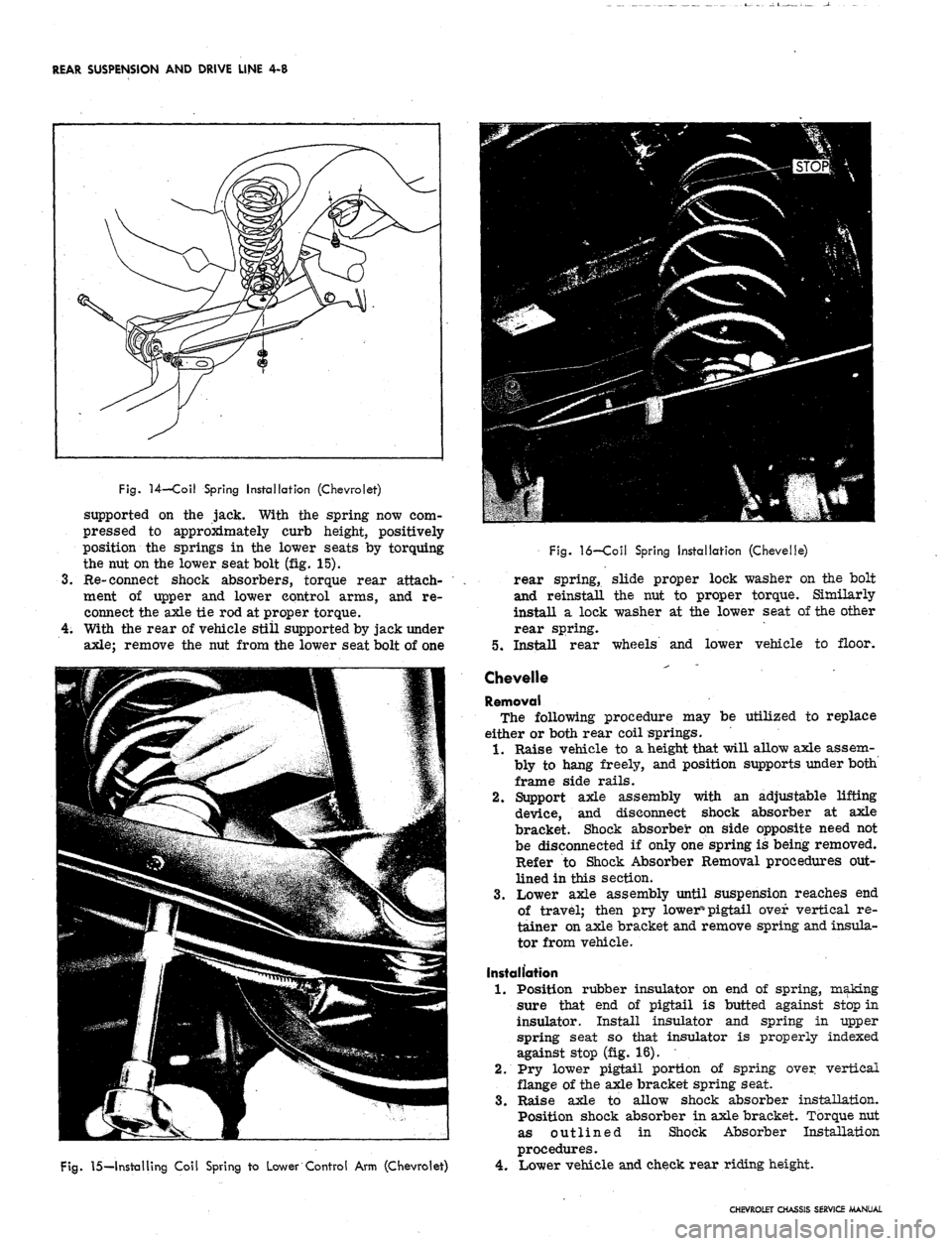
REAR SUSPENSION AND DRIVE LINE 4-8
Fig.
14—Coil Spring Installation (Chevrolet)
supported on the jack. With the spring now com-
pressed to approximately curb height, positively
position the springs in the lower seats by torquing
the nut on the lower seat bolt (fig. 15).
Re-connect shock absorbers, torque rear attach-
ment of upper and lower control arms, and re-
connect the axle tie rod at proper torque.
With the rear of vehicle still supported by jack under
axle;
remove the nut from the lower seat bolt of one
Fig.
15—Installing Coil Spring to Lower Control Arm (Chevrolet)
Fig.
16—Coil Spring Installation (Chevelle)
rear spring, slide proper lock washer on the bolt
and reinstall the nut to proper torque. Similarly
install a lock washer at the lower seat of the other
rear spring.
5.
Install rear wheels and lower vehicle to floor.
Chevelle
Removal
The following procedure may be utilized to replace
either or both rear coil springs.
1.
Raise vehicle to a height that will allow axle assem-
bly to hang freely, and position supports under both
frame side rails.
2.
Support axle assembly with an adjustable lifting
device, and disconnect shock absorber at axle
bracket. Shock absorber on side opposite need not
be disconnected if only one spring is being removed.
Refer to Shock Absorber Removal procedures out-
lined in this section.
3.
Lower axle assembly until suspension reaches end
of travel; then pry lower% pigtail over vertical re-
tainer on axle bracket and remove spring and insula-
tor from vehicle.
Installation
1.
Position rubber insulator on end of spring, making
sure that end of pigtail is butted against stop in
insulator. Install insulator and spring in upper
spring seat so that insulator is properly indexed
against stop (fig. 16).
2.
Pry lower pigtail portion of spring over vertical
flange of the axle bracket spring seat.
3.
Raise axle to allow shock absorber installation.
Position shock absorber in axle bracket. Torque nut
as outlined in Shock Absorber Installation
procedures.
4.
Lower vehicle and check rear riding height.
CHEVROLET CHASSIS SERVICE MANUAL
Page 199 of 659
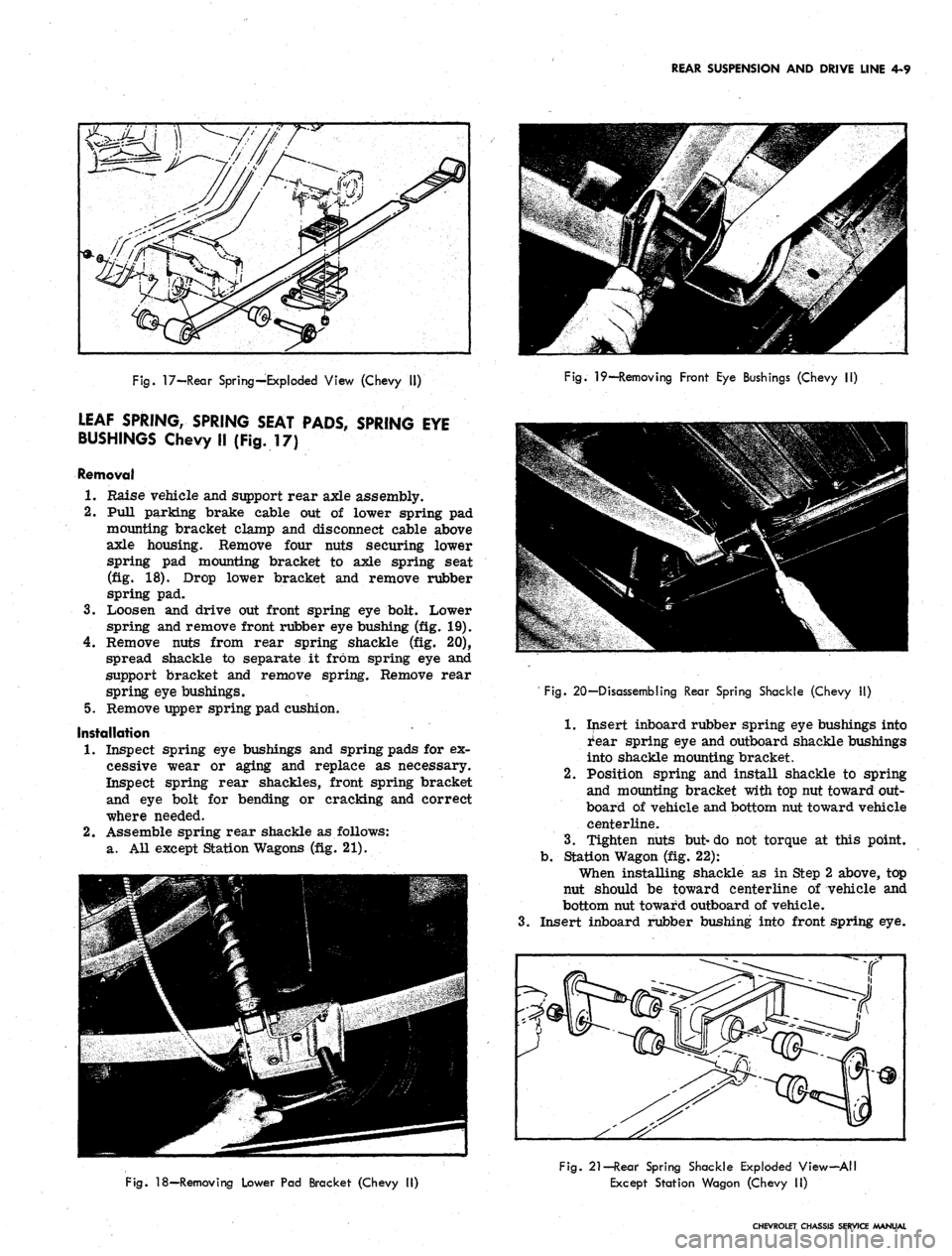
REAR SUSPENSION AND DRIVE LINE 4-9
Fig.
17—Rear Spring—Exploded View (Chevy II)
LEAF SPRING, SPRING SEAT PADS, SPRING EYE
BUSHINGS Chevy II (Fig. 17)
Removal
1.
Raise vehicle and support rear axle assembly.
2.
Pull parking brake cable out of lower spring pad
mounting bracket clamp and disconnect cable above
axle housing. Remove four nuts securing lower
spring pad mounting bracket to axle spring seat
(fig. 18). Drop lower bracket and remove rubber
spring pad.
3.
Loosen and drive out front spring eye bolt. Lower
spring and remove front rubber eye bushing (fig. 19).
4.
Remove nuts from rear spring shackle (fig. 20),
spread shackle to separate it from spring eye and
support bracket and remove spring. Remove rear
spring eye bushings.
5.
Remove upper spring pad cushion.
Installation
1.
Inspect spring eye bushings and spring pads for ex-
cessive wear or aging and replace as necessary.
Inspect spring rear shackles, front spring bracket
and eye bolt for bending or cracking and correct
where needed.
2.
Assemble spring rear shackle as follows:
a. All except Station Wagons (fig. 21).
Fig.
19—Removing Front Eye Bushings (Chevy II)
3.
' Fig. 20—Disassembling Rear Spring Shackle (Chevy II)
1.
Insert inboard rubber spring eye bushings into
i'ear spring eye and outboard shackle bushings
into shackle mounting bracket.
2.
Position spring and install shackle to spring
and mounting bracket with top nut toward out-
board of vehicle and bottom nut toward vehicle
centerline.
3.
Tighten nuts but-do not torque at this point,
b.
Station Wagon (fig. 22):
When installing shackle as in Step 2 above, top
nut should be toward centerline of vehicle and
bottom nut toward outboard of vehicle.
Insert inboard rubber bushing into front spring eye.
Fig.
18—Removing Lower Pad Bracket (Chevy II)
Fig.
21—Rear Spring Shackle Exploded View-All
Except Station Wagon (Chevy II)
CHEVROLET CHASSIS SERVICE MANUAL
Page 200 of 659
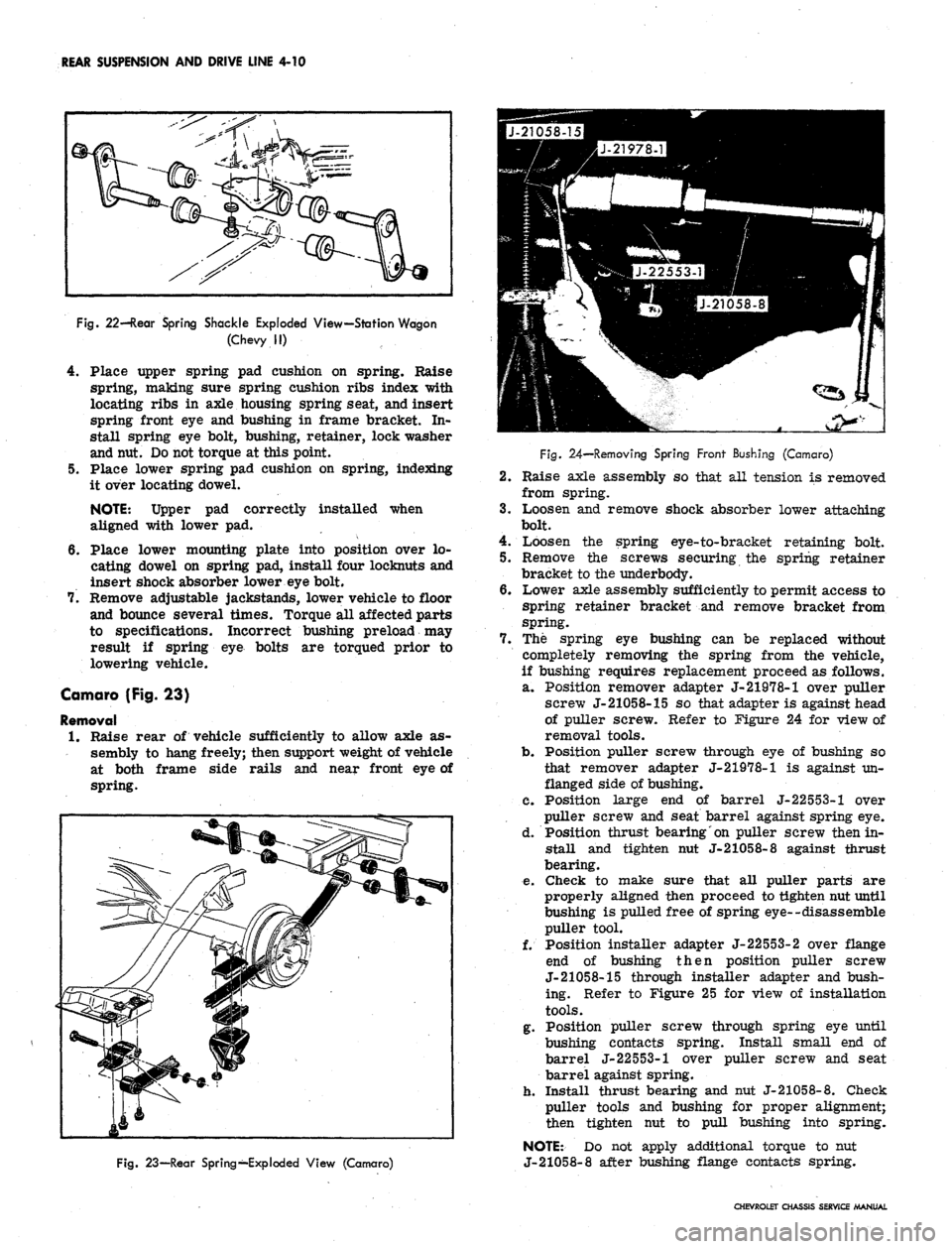
REAR SUSPENSION AND DRIVE LINE 4-10
Fig.
22—Rear Spring Shackle Exploded View—Station Wagon
(Chevy II)
4.
Place upper spring pad cushion on spring. Raise
spring, making sure spring cushion ribs index with
locating ribs in axle housing spring seat, and insert
spring front eye and bushing in frame bracket. In-
stall spring eye bolt, bushing, retainer, lock washer
and nut. Do not torque at this point.
5.
Place lower spring pad cushion on spring, indexing
it over locating dowel.
NOTE: Upper pad correctly installed when
aligned with lower pad.
6. Place lower mounting plate into position over lo-
cating dowel on spring pad, install four locknuts and
insert shock absorber lower eye bolt.
7.
Remove adjustable jackstands, lower vehicle to floor
and bounce several times. Torque all affected parts
to specifications. Incorrect bushing preload may
result if spring eye bolts are torqued prior to
lowering vehicle.
Camaro (Fig. 23)
Removal
1.
Raise rear of vehicle sufficiently to allow axle as-
sembly to hang freely; then support weight of vehicle
at both frame side rails and near front eye of
spring.
Fig.
23—Rear Spring—Exploded View (Camaro)
Fig.
24—Removing Spring Front Bushing (Camaro)
2.
Raise axle assembly so that all tension is removed
from spring.
3.
Loosen and remove shock absorber lower attaching
bolt.
4.
Loosen the spring eye-to-bracket retaining bolt.
5.
Remove the screws securing the spring retainer
bracket to the underbody.
6. Lower axle assembly sufficiently to permit access to
spring retainer bracket and remove bracket from
spring.
7.
The spring eye bushing can be replaced without
completely removing the spring from the vehicle,
if bushing requires replacement proceed as follows.
a. Position remover adapter J-21978-1 over puller
screw J-21058-15 so that adapter is against head
of puller screw. Refer to Figure 24 for view of
removal tools.
b.
Position puller screw through eye of bushing so
that remover adapter J-21978-1 is against un-
flanged side of bushing.
C. Position large end of barrel J-22553-1 over
puller screw and seat barrel against spring eye.
d. Position thrust bearing on puller screw then in-
stall and tighten nut J-21058-8 against thrust
bearing.
e. Check to make sure that all puller parts are
properly aligned then proceed to tighten nut until
bushing is pulled free of spring eye--disassemble
puller tool.
f. Position installer adapter J-22553-2 over flange
end of bushing then position puller screw
J-21058-15 through installer adapter and bush-
ing. Refer to Figure 25 for view of installation
tools.
g. Position puller screw through spring eye until
bushing contacts spring. Install small end of
barrel J-22553-1 over puller screw and seat
barrel against spring.
h. Install thrust bearing and nut J-21058-8. Check
puller tools and bushing for proper alignment;
then tighten nut to pull bushing into spring.
NOTE: Do not apply additional torque to nut
J-21058-8 after bushing flange contacts spring.
CHEVROLET CHASSIS SERVICE MANUAL